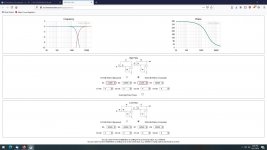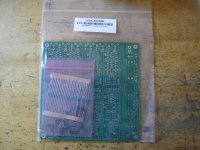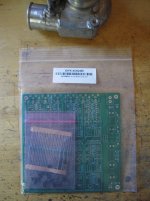If the 24V and 100mA mentioned above, I think the Silent Switcher will not do it. It can give +/-24V and 50mA.
This circuit is designed around a single-ended supply.
It would require modification for dual supplies.
It would require modification for dual supplies.
OK, thanks for your reply. It looked like a virtual ground is used at the midpoint giving plus or minus 12 volts.
Trying to get up to speed here on something new. I need a four pole crossover for both high and low pass at 2.5kHz. The PDF says,
😕
Regards,
Dan
Also you can't see the value for C in the filters: That is determined by the center frequency that you want. Normally we will use the same value for C everywhere,with C/2 being half that value, as will be discussed shortly
😕
Regards,
Dan
Just to make sure my own understanding of the circuit is clear. As the lower jFet of each pair is a CCS feeding the upper jFet isn't total consumption nominally 48mA ?
Thanks
Thanks
Using the Biamp 6-24 Crossover with a powered Sub
Hi Everyone,
Can anyone recommend C & C/2 values which allow for a hi-low crossover point of 70-80hz? Is such a thing feasible with this circuit? Please let me know...Thanks!
Hi Everyone,
Can anyone recommend C & C/2 values which allow for a hi-low crossover point of 70-80hz? Is such a thing feasible with this circuit? Please let me know...Thanks!
Trying to get up to speed here on something new. I need a four pole crossover for both high and low pass at 2.5kHz. The PDF says,
😕
Regards,
Dan
After some reading the 2.5kHz four pole capacitance value would be 3nF?
C=7000/2500 =nF
Regards,
Dan
Most of the commentary here has been about crossover functionality.
Be also mindful of differences in power amp and or driver sensitivity.
The goal is to find the right balance of noise and headroom. This is a SE circuit with about 5 volts output as l recall. So you want to have an amp input sensitivity of 1.4 volts ref 100 Watts (8 ohms) no higher than 2.8 volts ref 100 watts (8 ohms) to maintain a margin of headroom. This corresponds to 26 dB and 20 dB of power amp gain. Match power amp gain is preferred. A difference of 6 dB in power amp gain is acceptable provided headroom margin is observed to avoid clipping the crossover.
If you are using a horn of 107 dB sensitivity with is typical and a woofer of 95 sensitivity pad back the horn with a 10 dB passive attenuation between the amp and the horn to reduce noise.
Be also mindful of differences in power amp and or driver sensitivity.
The goal is to find the right balance of noise and headroom. This is a SE circuit with about 5 volts output as l recall. So you want to have an amp input sensitivity of 1.4 volts ref 100 Watts (8 ohms) no higher than 2.8 volts ref 100 watts (8 ohms) to maintain a margin of headroom. This corresponds to 26 dB and 20 dB of power amp gain. Match power amp gain is preferred. A difference of 6 dB in power amp gain is acceptable provided headroom margin is observed to avoid clipping the crossover.
If you are using a horn of 107 dB sensitivity with is typical and a woofer of 95 sensitivity pad back the horn with a 10 dB passive attenuation between the amp and the horn to reduce noise.
After some reading the 2.5kHz four pole capacitance value would be 3nF?
C=7000/2500 =nF
Regards,
Dan
Corresponds with my interpretation also.
Haven't auditioned this coaxial speaker but this could be good in a SLOB.
FaitalPRO | Coaxial Loudspeakers | 12HX230
Just add a 15" for the slot.
FaitalPRO | Coaxial Loudspeakers | 12HX230
Just add a 15" for the slot.
Here’s a link to Mike Rothacher’s component value calculator that Nelson refers to on page 11 of the write-up, it’s pretty neat! It looks like you’ll want to be somewhere around 100-150nF (0.1-0.15uF) using the default resistor values in the calculator. 0.15uF is a standard value for Wima, unfortunately 0.075uF is not. Another smart design feature is the frequency is adjustable by the potentiometers, so you’ll have some adjustment range. For such a low crossover frequency you might set the center point a bit higher just to have a more useable range - since there aren’t too many (audio) applications for a crossover frequency below 30Hz.
PASS XO CALC
PASS XO CALC
Hi Everyone,
Can anyone recommend C & C/2 values which allow for a hi-low crossover point of 70-80hz? Is such a thing feasible with this circuit? Please let me know...Thanks!
Most of the commentary here has been about crossover functionality.
Be also mindful of differences in power amp and or driver sensitivity.
The goal is to find the right balance of noise and headroom. This is a SE circuit with about 5 volts output as l recall. So you want to have an amp input sensitivity of 1.4 volts ref 100 Watts (8 ohms) no higher than 2.8 volts ref 100 watts (8 ohms) to maintain a margin of headroom. This corresponds to 26 dB and 20 dB of power amp gain. Match power amp gain is preferred. A difference of 6 dB in power amp gain is acceptable provided headroom margin is observed to avoid clipping the crossover.
If you are using a horn of 107 dB sensitivity with is typical and a woofer of 95 sensitivity pad back the horn with a 10 dB passive attenuation between the amp and the horn to reduce noise.
This is interesting.
When you mean passive attenuation, do you mean something like a pot (or resistor) or something more complex like a B1 buffer?
Thanks,
-Josh
Olen, thanks for the helpful information! I'll play with the filter app and see where it takes me.
I almost all cases, we need to tailor the response of the crossover to suit our speakers. Those strict 6/12/18/24 dB/octave is rarely what is needed.
yup
like always, you need to start somewhere with xover development, whichever sort of xover you intend to use - active or passive or combined
like always, you need to start somewhere with xover development, whichever sort of xover you intend to use - active or passive or combined
- Home
- Amplifiers
- Pass Labs
- DIY biamp 6-24 crossover



